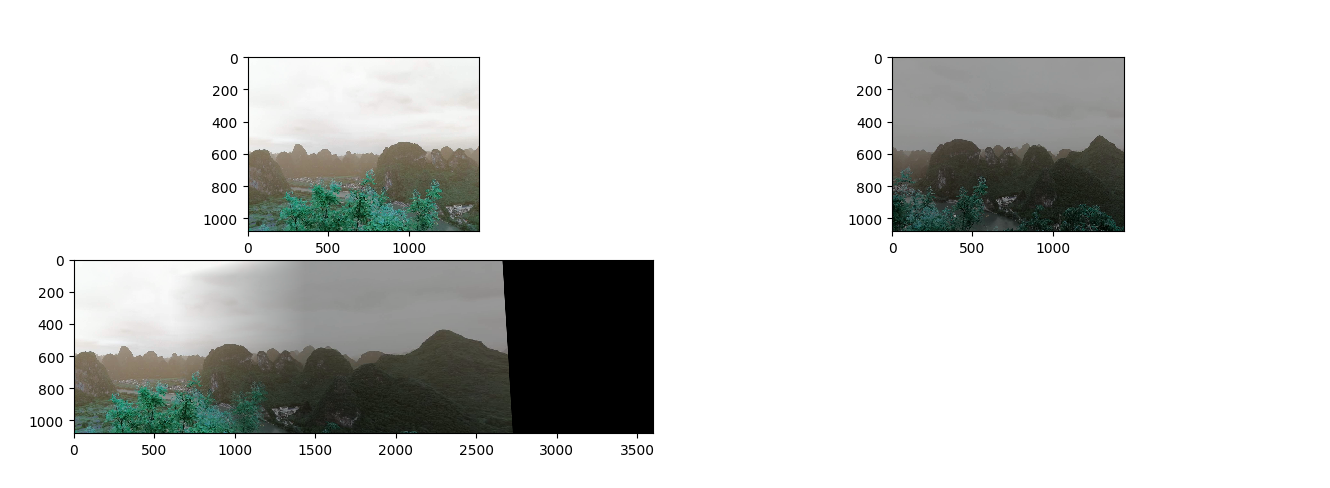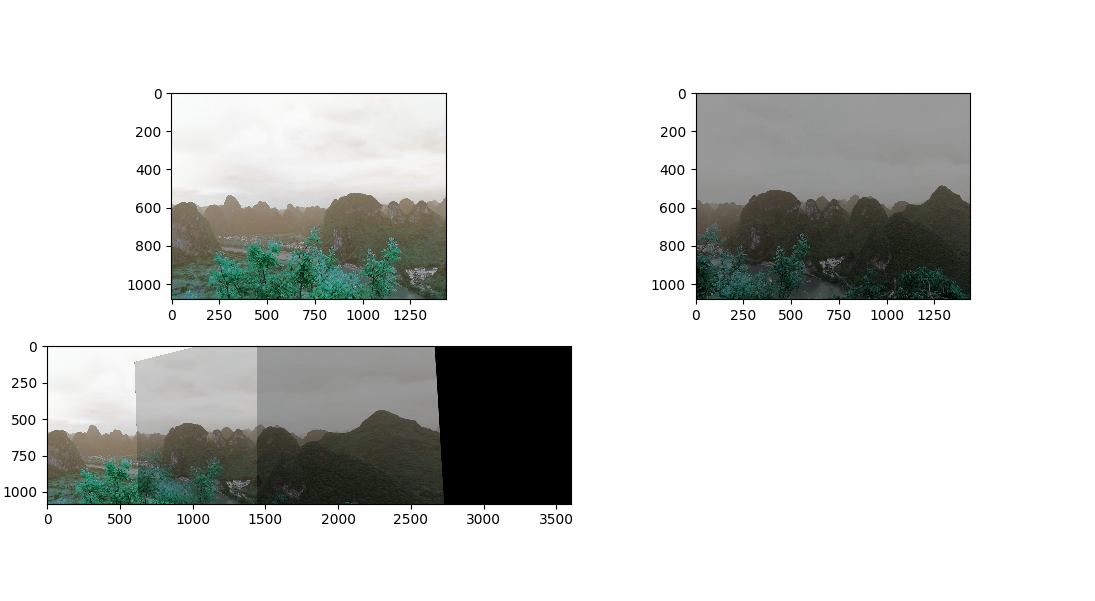1. 收藏链接:https://blog.youkuaiyun.com/wd1603926823/article/details/49582461
一、2幅图像拼接
流程1>>>提取局部特征,计算特征点对应,本文使用rootSIFT计算特征点的最近邻,然后帅选优质最近邻(最近邻距离<0.2*次近邻距离,这里的0.2是自定义的)
流程2>>>检验单应矩阵是否符合要求,参考论文[1] 中“内点对总数>5.9+0.22*总点对数”
流程3>>>按重叠区范围线性加权融合图像
import cv2, math
from pyflann import *
import matplotlib.pyplot as plt
class Stitching2Img:
def __init__(self):
pass
def __rootSIFT_extract(self, img_path, crop=None):
'''
rootsift= sqrt( sift / sum(sift) )
:param img_path: the abs_path of image
:param crop: a list with 4 members denoting [low, up, left, right]
:return: np.sqrt(sift_vector/max(sift_vector)), if needed do l2-moralization after extraction
'''
sift = cv2.xfeatures2d.SIFT_create()
img = cv2.imread(img_path, cv2.IMREAD_GRAYSCALE)
if img is None:
print(img_path, "is not readable")
raise Exception(img_path + " is not readable")
if crop is not None:
img = img[crop[0]:crop[1], crop[2]:crop[3]]
kp, des = sift.detectAndCompute(img, mask=None)
if (des is not None) and (len(des) > 0):
des_filted = []
kp_filted = []
des_sum = np.sum(des, axis=1)
des_sum_nonzero_index = np.argwhere(des_sum).reshape((-1,))
for des_i in des_sum_nonzero_index:
des_filted.append(des[des_i] / des_sum[des_i])
kp_filted.append(kp[des_i])
des_filted = np.sqrt(np.array(des_filted))
else:
des_filted = des
kp_filted = kp
return kp_filted, des_filted
def __loadImages(self, imgs_path):
self.__params = np.random.random(size=(len(imgs_path), 4))
self.__imgspath = []
self.__imgspath.extend(imgs_path)
self.__imgs = []
for img_path in imgs_path:
self.__imgs.append(self.__rootSIFT_extract(img_path))
self.__get_adjacent()
return
def __get_adjacent(self):
num_imgs = len(self.__imgs)
adjacent = [[[] for i in range(num_imgs)] for i in range(num_imgs)]
for img_i in range(num_imgs):
for img_j in range(img_i + 1, num_imgs):
M, matched_pts = self.__get_M_ptpair(img_i, img_j)
adjacent[img_i][img_j].append((M, matched_pts))
adjacent[img_j][img_i].append((np.linalg.inv(M), [matched_pts[1], matched_pts[0]]))
self.__adjacent = adjacent
return
def __get_M_ptpair(self,img_i,img_j,threshold=0.2):
'''
X_j=M*X_i
:param img_i: the index of images
:param img_j: the index of images
:param threshold: the threshold of RANSAC
:return: M, matched_pts
'''
myflann = FLANN()
descriptor_img0 = self.__imgs[img_i][1]
descriptor_img1 = self.__imgs[img_j][1]
result, dists = myflann.nn(descriptor_img0, descriptor_img1, 2, algorithm='linear')
# (np.array(words, dtype='float32'),np.array(des, dtype='float32'),1,
# algorithm="kdtree", trees=8, checks=512)
match_filter = dists[:, 0] / dists[:, 1] < threshold
matched_pts = [[], []]
for i, item in enumerate(match_filter):
if not item:
continue
matched_pts[1].append(self.__imgs[1][0][i].pt)
matched_pts[0].append(self.__imgs[0][0][result[i][0]].pt)
if len(matched_pts[0]) <= 8:
return None, None
M, mask = cv2.findHomography(np.float32(matched_pts[0]), np.float32(matched_pts[1]), cv2.RANSAC, 1.0)
matchesMask = mask.ravel()
if not sum(matchesMask)>5.9+0.22*len(matchesMask):#is it OK here?
return None,None
else:
return M, matched_pts
def stitching2images(self, left_img, right_img):
'''
:param left_img: the absolute path of left_img
:param right_img: the absolute path of right_img
:return: None
'''
self.__loadImages([left_img, right_img])
M = self.__adjacent[1][0][0][0]
im0 = cv2.imread(self.__imgspath[0], 1)
im1 = cv2.imread(self.__imgspath[1], 1)
h, w = im1.shape[0], im0.shape[1]
im3 = cv2.warpPerspective(im1, M, (math.floor(2.5 * w), h)) # warpAffine
for h_i in range(h):
cur_l = -1
cur_r = -1
for w_i in range(w):
if sum(im3[h_i][w_i]) / 3 > 0.001 and sum(im0[h_i][w_i]) / 3 > 0.001:
if cur_l < 0 and cur_r < 0:
cur_l = w_i
elif cur_l > 0:
cur_r = w_i
if sum(im3[h_i][w_i]) / 3 > 0.001 and sum(im0[h_i][w_i]) / 3 < 0.001:
if cur_l > 0 and cur_r > 0:
break
ler2l = cur_r - cur_l
for w_i in range(w):
if w_i < cur_l:
im3[h_i][w_i] = im0[h_i][w_i]
elif w_i >= cur_l and w_i < cur_r:
f_l = (w_i - cur_l) / ler2l
f_r = (cur_r - w_i) / ler2l
im3[h_i][w_i] = im3[h_i][w_i] * f_l + im0[h_i][w_i] * f_r
fig = plt.figure()
fig.add_subplot('221')
plt.imshow(im0)
fig.add_subplot('222')
plt.imshow(im1)
fig.add_subplot('223')
plt.imshow(im3)
plt.show()
return
def __call__(self, *args, **kwargs):
self.stitching2images(left_img=kwargs['left_img'],right_img=kwargs['right_img'])
if __name__ == '__main__':
stitch = Stitching2Img()
# stitch(left_img=os.getcwd() + "/stitch1.jpg", right_img=os.getcwd() + "/stitch2.jpg")
stitch(left_img=os.getcwd() + "/2_2.jpg", right_img=os.getcwd() + "/1_1.jpg")线性加权融合效果展示:

修改拼接函数成固定权重融合
def stitching2images(self,left_img,right_img):
self.loadImages([left_img,right_img])
M = self.__adjacent[1][0][0][0]
im0 = cv2.imread(self.__imgspath[0], 1)
im1 = cv2.imread(self.__imgspath[1],1)
h,w=im1.shape[0],im0.shape[1]
im3=cv2.warpPerspective(im1,M,(math.floor(2.5*w),h))#warpAffine
for h_i in range(h):
for w_i in range(w):
if sum(im3[h_i][w_i])/3>0.001 and sum(im0[h_i][w_i])/3>0.001:
im3[h_i][w_i] = im3[h_i][w_i] * 0.5 + im0[h_i][w_i] * 0.5
if sum(im3[h_i][w_i]) / 3 < 0.001 and sum(im0[h_i][w_i]) / 3 > 0.001:
im3[h_i][w_i] = im0[h_i][w_i]
fig=plt.figure()
fig.add_subplot('221')
plt.imshow(im0)
fig.add_subplot('222')
plt.imshow(im1)
fig.add_subplot('223')
plt.imshow(im3)
plt.show()
return此时的拼接效果:

参考文献
[1] Brown M, Lowe D G. Recognising Panoramas[C]. IEEE International Conference on Computer Vision. IEEE Computer Society, 2003:1218.
-----------未完成---------





















 4744
4744

 被折叠的 条评论
为什么被折叠?
被折叠的 条评论
为什么被折叠?








